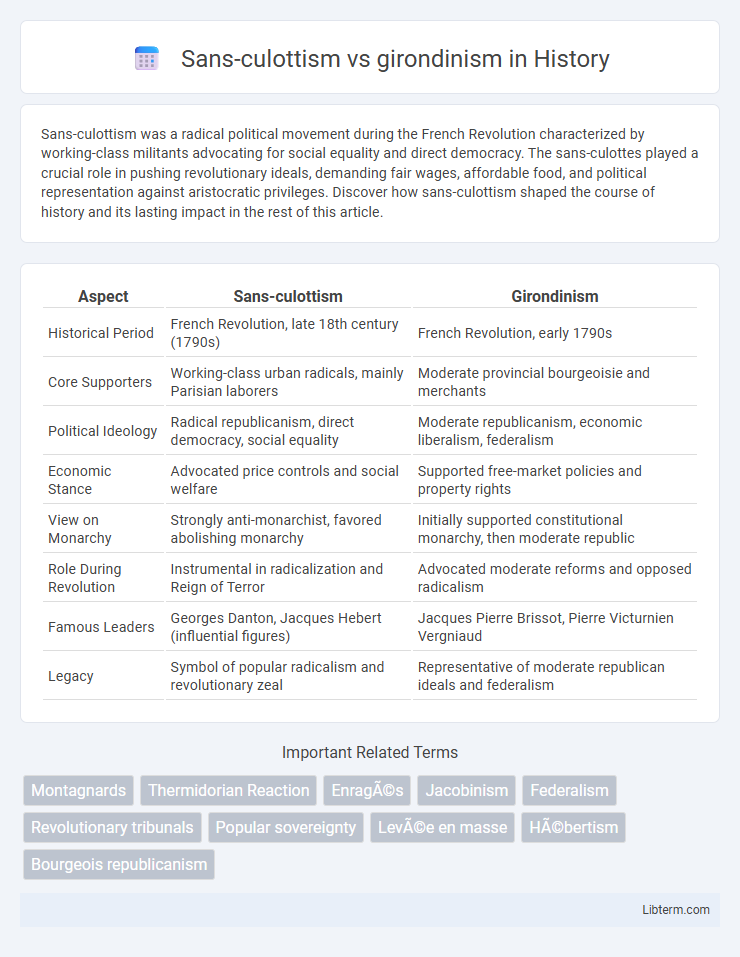Sans-culottism was a radical political movement during the French Revolution characterized by working-class militants advocating for social equality and direct democracy. The sans-culottes played a crucial role in pushing revolutionary ideals, demanding fair wages, affordable food, and political representation against aristocratic privileges. Discover how sans-culottism shaped the course of history and its lasting impact in the rest of this article.
Table of Comparison
| Aspect | Sans-culottism | Girondinism |
|---|---|---|
| Historical Period | French Revolution, late 18th century (1790s) | French Revolution, early 1790s |
| Core Supporters | Working-class urban radicals, mainly Parisian laborers | Moderate provincial bourgeoisie and merchants |
| Political Ideology | Radical republicanism, direct democracy, social equality | Moderate republicanism, economic liberalism, federalism |
| Economic Stance | Advocated price controls and social welfare | Supported free-market policies and property rights |
| View on Monarchy | Strongly anti-monarchist, favored abolishing monarchy | Initially supported constitutional monarchy, then moderate republic |
| Role During Revolution | Instrumental in radicalization and Reign of Terror | Advocated moderate reforms and opposed radicalism |
| Famous Leaders | Georges Danton, Jacques Hebert (influential figures) | Jacques Pierre Brissot, Pierre Victurnien Vergniaud |
| Legacy | Symbol of popular radicalism and revolutionary zeal | Representative of moderate republican ideals and federalism |
Introduction to Sans-culottism and Girondinism
Sans-culottism represented the radical, working-class faction during the French Revolution, advocating for direct democracy, social equality, and price controls to protect the poor. Girondinism, associated with the Girondins, embodied a more moderate, bourgeois political stance favoring federalism, free-market principles, and cautious reform to maintain stability. These two ideologies clashed over the direction of revolutionary governance, with sans-culottes pushing for urgent and profound social change while Girondins promoted measured progress and legal reforms.
Historical Context: The French Revolution’s Factions
Sans-culottism represented the radical working-class movement during the French Revolution, advocating for direct democracy, social equality, and vigilant opposition to royalist and aristocratic influences. Girondinism reflected the moderate republican faction emphasizing constitutionalism, economic liberalism, and cautious reform to preserve bourgeois interests. Their conflict underscored the broader struggle between radical populist demands and moderate political control within revolutionary France's volatile political landscape.
Ideological Foundations of Sans-culottism
Sans-culottism is rooted in radical egalitarianism, advocating for direct popular democracy and the empowerment of working-class citizens during the French Revolution. It emphasizes social justice, economic equality, and active participation in political processes to dismantle aristocratic privilege. This contrasts with Girondinism's more moderate republicanism and focus on constitutionalism and property rights.
Core Beliefs of Girondinism
Girondinism emphasized moderate republicanism, advocating for constitutional government and the protection of individual liberties, with a firm belief in limited government intervention in the economy. Girondins supported federalism, favoring decentralization of power away from Paris to the provinces, and upheld the importance of property rights and free trade. Their core beliefs contrasted sharply with the radical and populist ideals of Sans-culottism, which championed direct democracy and economic equality.
Socioeconomic Composition of Each Movement
Sans-culottism was predominantly composed of working-class Parisians, including artisans, laborers, and small shopkeepers who demanded radical social and economic reforms to address inequality and poverty. Girondinism drew its support mainly from the bourgeoisie and provincial elites, such as merchants, professionals, and landowners, advocating for moderate republicanism and economic liberalism. The contrasting socioeconomic compositions influenced their political agendas, with sans-culottes pushing for direct democracy and wealth redistribution while Girondins favored property rights and a more conservative economic structure.
Key Leaders and Influential Figures
Sans-culottism was driven by radical working-class leaders like Jacques Roux and Francois Hanriot, who championed direct action and social equality during the French Revolution. Girondinism featured moderate intellectuals such as Jacques Pierre Brissot and Jacques Verges, who advocated for liberal reforms and parliamentary governance. These contrasting leadership styles reflected the broader ideological divide between the radical sans-culottes and the more conservative Girondins.
Policy Differences: Economy, War, and Governance
Sans-culottism emphasized radical economic policies such as price controls and wealth redistribution to support the working class, while Girondinism favored free-market principles and limited government intervention. In matters of war, Sans-culottes advocated for aggressive revolutionary warfare to defend the republic and spread radical ideals, whereas Girondins promoted more cautious military engagement aimed at preserving stability. Governance under Sans-culottism supported direct popular control and the empowerment of revolutionary tribunals, contrasting with Girondinism's preference for representative institutions and constitutional checks.
Major Conflicts and Clashes Between the Groups
Sans-culottism and Girondinism clashed primarily over political power and revolutionary direction during the French Revolution, with Sans-culottes demanding radical measures such as price controls and direct democracy, while Girondins advocated for a more moderate, bourgeois-led republic. The Girondins' reluctance to support the September Massacres and their opposition to the execution of Louis XVI intensified tensions, leading to violent confrontations and the Girondins' eventual purge in 1793. These conflicts highlighted the deep social and ideological rifts, as Sans-culottes pushed for egalitarian economic policies and expansive popular sovereignty against the Girondins' emphasis on property rights and legal restraint.
Impact on Revolutionary Politics and Society
Sans-culottism fueled radical revolutionary politics by advocating for direct democracy, social equality, and vigorous opposition to monarchy and aristocracy, which mobilized the working-class Parisian population. Girondinism promoted a more moderate republicanism, emphasizing federalism, cautious reform, and protection of property rights, appealing to the provincial bourgeoisie and merchant classes. The conflict between these ideologies intensified political polarization, leading to purges, the Reign of Terror, and reshaping the social order through class-based revolutionary governance.
Legacy and Modern Interpretations
Sans-culottism, embodying radical populism and direct democracy during the French Revolution, is often interpreted in modern times as a symbol of grassroots activism and social justice movements challenging established elites. Girondinism, representing moderate republicanism and emphasis on legal order, influences contemporary liberal democratic ideals favoring constitutionalism and political pluralism. The legacy of these opposing factions informs debates on revolutionary legitimacy, the balance between popular sovereignty and institutional stability, and the evolution of political radicalism versus moderation in modern democracies.
Sans-culottism Infographic

 libterm.com
libterm.com